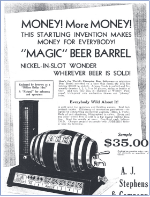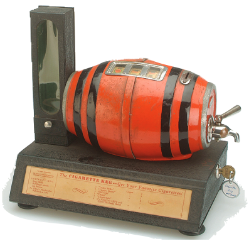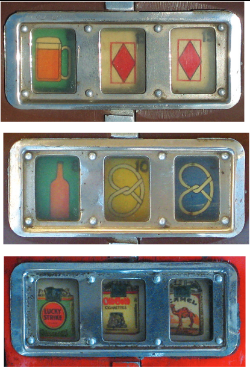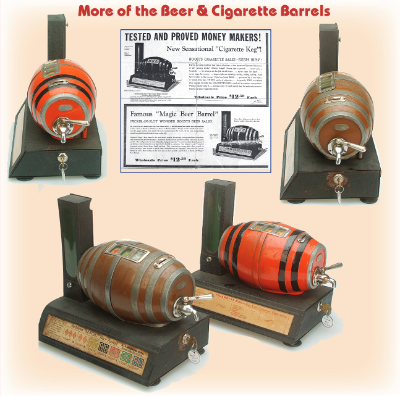The End of Prohibition
By Johhny Duckworth
 Eighty-six years ago, the A.J. Stephans Company located in Kansas City,Missouri created ywo very unique
trade stimulators for all of us to enjoy in our collections today. Prohibition ended in December of 1933
and the Stephens Company introduced the Magic Beer Barrel" the following year. This small little
countertop machine practically screams, "prohibition has ended" with the body of the machine shaped as a
beer barrel lying on its side, a vender filled with pretzles on the left, and a beer tap hanging out the
right end of the barrel. The machine had so much success that they went on to create a cigarette version
as well called the "Cigarette Keg". Both machines have lots of character and have become quite popular
with with collectors over the years. The advertised flyers stated that the machines would boost sales for
both beer and cigarettes while only costing $12.50 each; they could hold $80.00 worth of nickles in the
cash box, and were also noted for paying out 50% in merchandise. You will notice one of the flyers shown
has the beer barrel priced at $35.00; this would have been very steep for an aluminum trade stimulator in
the 30's.
Eighty-six years ago, the A.J. Stephans Company located in Kansas City,Missouri created ywo very unique
trade stimulators for all of us to enjoy in our collections today. Prohibition ended in December of 1933
and the Stephens Company introduced the Magic Beer Barrel" the following year. This small little
countertop machine practically screams, "prohibition has ended" with the body of the machine shaped as a
beer barrel lying on its side, a vender filled with pretzles on the left, and a beer tap hanging out the
right end of the barrel. The machine had so much success that they went on to create a cigarette version
as well called the "Cigarette Keg". Both machines have lots of character and have become quite popular
with with collectors over the years. The advertised flyers stated that the machines would boost sales for
both beer and cigarettes while only costing $12.50 each; they could hold $80.00 worth of nickles in the
cash box, and were also noted for paying out 50% in merchandise. You will notice one of the flyers shown
has the beer barrel priced at $35.00; this would have been very steep for an aluminum trade stimulator in
the 30's.
The machines are very simple to play; simply drop a nickel in the slot, pull the handle on the beer tap and the reels will spin. On the beer barrel version the player is trying to win one,two,three,five, or ten beers and in the process will also get a pretzel from the vender on the left side, if desired. Some of the instruction cards will have the beer payouts changed in favor of the store owner. This was done simply by pasting different beer counts over the paper payout card in the front. The first reel on the left shows beer bottles and beer mugs to determine if the payout will be in the form of bottles or a draw. The other two reels on the right show pretzles with five different colored backgrounds. Simply match two of the same colors on the reels to win. There are also diamonds shown on all three reels wich can make for a large beer payout of five or ten.
 The cigarette keg has the same design as the beer barrel but it's dressed a little different with an
orange painted barrel with black stripes. The player is trying to win cigarettes instead of beer in this
little machine and they will also get a pretzel or candy on every play, if desired. Five different
cigarette packs are placed on the three reels as well as a cigarette instruction card on the lower front.
To win you simply need to line up three packs of Lucky Strike, Twenty Grand, Old Gold, Camel or
Chesterfield wich will pay one,two, or three packs depending on the brand.Two of a kind can also be lined
up on the left and center reels to win one pack.
The cigarette keg has the same design as the beer barrel but it's dressed a little different with an
orange painted barrel with black stripes. The player is trying to win cigarettes instead of beer in this
little machine and they will also get a pretzel or candy on every play, if desired. Five different
cigarette packs are placed on the three reels as well as a cigarette instruction card on the lower front.
To win you simply need to line up three packs of Lucky Strike, Twenty Grand, Old Gold, Camel or
Chesterfield wich will pay one,two, or three packs depending on the brand.Two of a kind can also be lined
up on the left and center reels to win one pack.
There were quite a few of these machines sold, as the serial numbers look to have reached just over 3,000.I have located quite a few known serial numbers for this article with a huge thanks going to all the C.O.C.A members who were willing to share their information. The cigarette kegs have a special numbering system with a C starting before the serial.The lowest number observed on a cigarette keg has been in the low 2,700 range so these look to have been produced towards the end of production.It took two years to pry my first Cigarette Keg out of a collector in South Dakota. I then located another one in North Carolina and former "El Presidente" was kind enough to let it come back home to Kansas City. I just wonder how many more cigarette kegs are lurking out there in collections today.
 A.J. Stephans was born in Versailles, Missouri where his father ran a local drug store.He left home in
1903 at the young age of 12 to live with his uncle Wyan in Kansas City.Three years later his family would
move to Independence, Missouri just located outside of Kansas City and he moved back in with them at that
time.He would travel into the city by train where he worked for the Miissouri Pacific Railroad at the
roundhouse in the east bottoms.He also became life-long friends with Harry Truman who also happened to
be from Independence, before Mr.Truman entered the office as president.
A.J. Stephans was born in Versailles, Missouri where his father ran a local drug store.He left home in
1903 at the young age of 12 to live with his uncle Wyan in Kansas City.Three years later his family would
move to Independence, Missouri just located outside of Kansas City and he moved back in with them at that
time.He would travel into the city by train where he worked for the Miissouri Pacific Railroad at the
roundhouse in the east bottoms.He also became life-long friends with Harry Truman who also happened to
be from Independence, before Mr.Truman entered the office as president.
A.J. Stephans started out building stone fixtures and then moved into manufacturing tires wich became a big business for him.At one time he had 256 associated stores that sold him tires until Sears, Western Auto, and Montgomery Wards jumped in.His factory located at 14th and Chestnut not only produced tires but they produced several other products as well, including these great trade stimulators. The A.J. Stephans factory also did a lot of government work during the war making duffle bags and aircraft parts. Montgomery Wards would put a stop to all his success when they ordered a million dollars worth of tires. Stephan's went out and spent $600,000 on rubber and fabric only to have the bottom fall out of rubber when it then went from 67 cents a pound a pound to 8 cents a pound. The order was cancelled and he lost almost a half million dollars.
The beer barrel and cigarette keg are two great looking machines wich would display well in anyone's collection. I want to thanks everyone again who took the time to send me serial numbers and I also would like to thank Tom Gustwiller for his help digging up the Stephens flyers. The last time my wife and I stopped to visit Tom and Bev they were kind enough to put us up in the penthouse suit...thank you!!! If you have any serial numbers you would like to share please email me at or call 816-835-3316.

